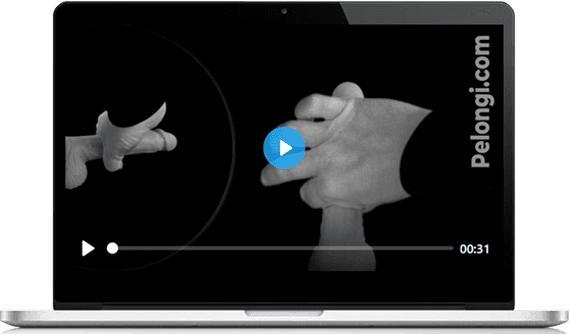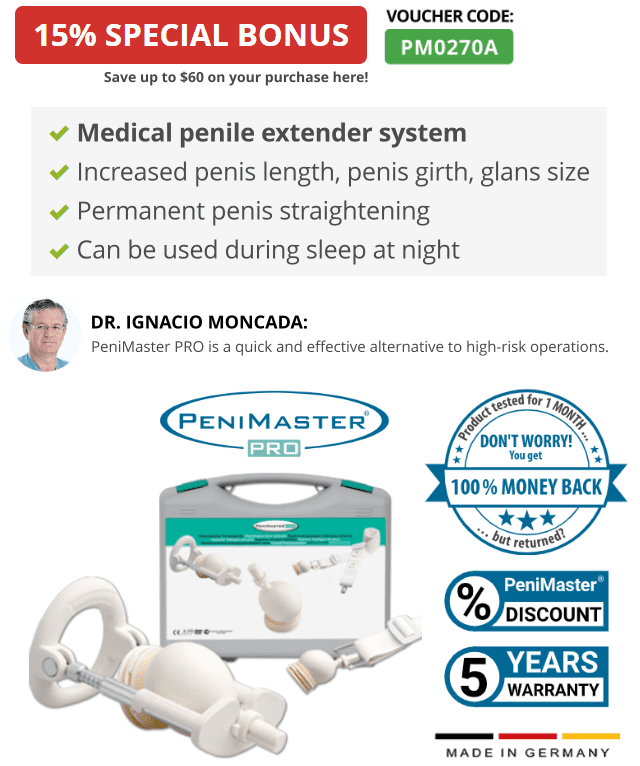Kegel Clench pelvic floor exercise for men
Results
- • Strengthen pelvic floor
Instruction
- • Beginners
Workout time
- • 2 times 5 minutes daily
Exercise
- Erection: 0-100%
- Exercise: beginners
- Difficulty: easy
- Intensity: low
- Injury risk: low
- Video
The Kegel Clench is the number one penis enlargement exercise for building strong pelvic floor muscles, commonly refered to as the PC muscles or sex muscles. Healthy pelvic floor muscles are essential to a healthy penis; they build harder, bigger and longer-lasting erections, provide greater control over ejaculation and blood flow, and produces stronger and more intense orgasms. Kegel exercises for men will improve the overall sex life, lead to greater sexual stamina and multiple orgasms, and builds a healthier prostate.
- Alternative name:
- PC muscle workout
- Kegel
- Reverse-Kegel
- Kegel exercise
- Anatomical focus:
- Pelvic floor
- Supported measured values:
- none
- Practice family:
- Complement exercise
- Related exercises:
- Warm up and Cool down (Beginners)
- Pelvic floor muscle training (Beginners)
- This penis enlargement exercise mainly targets pelvic floor muscles and increases:
- blood circulation
- ejaculation control
- ejaculation intensity
- ejaculation volume
- erection strength
- prostate health
Tutorial
Bring penis to the suggested erection level.
Clench the PC muscle and hold for the suggested rep time.
Release the PC muscle and repeat from step 2 until reaching the suggested number of reps.
Video
Background
The topic of pelvic floor muscles and their specific workout to increase sexual performance or for the prophylaxis of various sexual-anatomical clinical pictures is a widespread field of knowledge that has long been illuminated by the media. However, these reports are less detailed when it comes to the exact effect of the workout, the anatomical basics or a differentiated consideration of different pelvic floor exercises. Meanwhile, the pelvic floor muscles are primarily formed by three muscles: The Musculus pubococcygeus (pubic coccygeal muscle), the Musculus bulbospongiosus (urethral muscle) and the Musculus iliococcygeus (also part of the levator ani). The idea of strengthening these muscles through strain goes back to the ideas first published in 1948 by the American gynaecologist Arnold Henry Kegel, who consequently also gave his name to such exercises (hence: "Kegel exercise"). Another frequent name for these training methods is "PC muscle exercise", whereby this name refers to the musculus pubococcygeus as a short form. Meanwhile, the effect of successful pelvic floor training is beneficial for both sexes. For example, it prevents incontinence (e.g. due to age, pregnancy or prostate surgery), increases the blood flow to the genitals and also increases the ability to orgasm, the sensation of orgasm and the control of orgasm. It should be noted that a comprehensive pelvic floor workout is not only designed to strengthen the corresponding muscles, but also to improve their balance. Therefore, the workout is divided into two different exercises: The classic Kegel (a tension exercise) and the Reverse Kegel (a relaxation exercise). The Kegel exercise for men improves genital blood flow and provides harder and more reliable erections, while the Reverse Kegel exercise increases orgasm control and thus offers the possibility to delay the orgasm in spite of stimulation. Only when used in combination do the exercises lead to a pronounced pelvic floor musculature with all the positive aspects mentioned above.
Workout
As already mentioned, two separate exercises are necessary for the workout of the pelvic floor, which are performed together, if possible, i.e. in alternating sets. In the following, the localisation of both underlying muscle groups or aids for their targeted tensing and relaxation is described. As soon as the muscles can be specifically targeted, the actual exercises should then be performed without the corresponding localization aids.
Kegel
To locate the muscle group necessary for male Kegels, you can simply stop the urine stream for a short time when going to the toilet. The muscle group that is used to stop is the one that is activated to perform a Kegel. As soon as you have developed a feeling for this muscle group, the tension can be felt even when you are not urinating. If a Kegel is executed, there is also a so-called "Kegel-Pump", which manifests itself in a twitching of the penis shaft and, in the case of an existing erection, also leads to a short-term expansion of the erectile tissue. If you recognize this reaction after performing a Kegel, you know that the correct muscle group has been tensed. The actual Kegel workout can and should then work with different tension intervals. In the beginning, the muscle can usually only be tensed for a short time, but with increasing routine the tension can be maintained for several seconds. A comprehensive Kegel workout includes a wide range of tension intervals (sometimes short and sometimes long). The abdominal and leg muscles should not be involved in the Kegel exercise. In principle, the Kegel Clench can take place anywhere (even during a car ride, in an office chair or on the sofa at home), since there is no outwardly actually visible reaction. However, you should always make sure that you breathe calmly and evenly and concentrate on the tension if possible.
Reverse Kegel
While the Classic Kegel exercise is very easy for most men, the Reverse Kegel exercise is much more difficult. On the one hand, this is due to the fact that it does not cause a directly visible reaction (such as the twitching of the shaft of the Classic Kegels), but on the other hand it is also due to the fact that it is a targeted relaxation of the muscles, which requires significantly more concentration and body awareness than tension. Similar to the Kegel, there is also a possibility for the Reverse Kegel to force the relaxation of the corresponding muscle group and thus localize it. In the case of the Reverse Kegel, this is letting the urine stream run (front Reverse Kegel) or relaxing the sphincter muscles during defecation or flatulating (rear Reverse Kegel). As with the Kegel, however, the following applies: These actions only serve to locate the corresponding muscle group - you do not have to and should not force body excretions in order to perform the reverse cone correctly. Instead, one should use these actions to internalize the body feeling in the moments described and to be able to relax the muscles later in such a way that one can feel it. Almost more important than Kegel, Reverse Kegel requires steady, calm breathing and sufficient concentration. The duration of a targeted relaxation of the muscle group can also be varied again and again, whereby it is often worthwhile to have a Reverse Kegel followed by another Classic Kegel (so that a constant alternation of forced tension and relaxation is created).
General help with localization
Apart from the above-mentioned aids to locating the relevant muscle groups, there are some general tips that can help with the routine of pelvic floor exercises:
- Straight back:
-
At the beginning, it is advisable to perform the exercise in a standing or lying position. In any case, you should ensure that your back is as straight as possible, as this makes it easier to control the muscles.
- Alternating Kegel and Reverse Kegel exercises:
-
The direct alternation allows a clearer distinction between tension and relaxation of the respective muscle area.
- Help through touch:
-
If you place your fingers on the base of the penis or perineum, you can feel the movements of the muscles under the skin more clearly and directly. This often helps in determining whether a muscle is actually being targeted or not.
Additional Information
The following notes treat common questions regarding this exercise and provide further explanations of its fine-tuning and possible modifications.
- Even breathing:
-
It is easy to become so focused on tensing a muscle that you stop breathing regularly - which can ultimately lead to pelvic floor tension and ineffective workout. It is therefore important to breathe calmly and evenly when doing the exercises.
- Intuitive Kegels vs. Kegel program:
-
Sometimes the question arises whether the pelvic floor workout needs its own, precisely workout program (e.g. "10 Kegels with 1 second of tension, then 10 Kegels with 3 seconds of tension" etc.) or whether one can also simply intuitively Kegel and Reverse Kegel until the daily estimated workout time of these exercises is reached. In principle it can be said that an exact pelvic floor training plan is not necessary. However, if it helps someone to structure their workout, you can of course still guide them in every detail.
- Overloading of the pelvic floor:
-
Even though it is rather rare, it is in principle possible to overload the pelvic floor with too intensive (i.e. above all too long) workout. Such an overload usually manifests itself as sore muscles, which should be let subside completely before doing any further pelvic floor exercises. Such an overload can occur especially if the pelvic floor training is too one-sided (e.g. only Kegels are performed, but no relaxing Reverse Kegels. See also the additional note Balance of the pelvic floor muscles. You can prevent such an overload by doing the pelvic floor exercises only every second day, which gives the muscles more regeneration time between the workout stages.
- Kegel Exercise with counterweight:
-
An intensified form of Kegel is the execution of the exercise with a counterweight. To do this, you can, for example, place a towel over the erect penis, which is then pressed down by the weight (Towel raise). If you now perform a Kegel, you will notice a stronger resistance. The same can be achieved by lying on your back, pressing the erect penis on your belly and weighing it down from above. If you now Kegel, the penis has to push the additional weight (e.g. a light book) upwards, which makes the Kegel more intense and strains the pelvic floor muscles more. In general, Kegels with a counterweight is a good way to provide new training stimuli in the later course of pelvic floor training. However, especially with this application, care should be taken not to overload the muscles and, if in doubt, to allow them sufficient rest periods.
- Balance of the pelvic floor muscles:
-
Balance of the pelvic floor muscles: As mentioned earlier, the balance of the pelvic floor muscles is essential to be able to enjoy its benefits in their entirety. This balance is achieved mainly through a balanced use of Classic Kegels and Reverse Kegels. It is common for the Kegels to be perceived as much stronger than the Reverse Kegels - but this is usually not due to the exercise itself, but to the fact that the targeted relaxation of the muscles is often less important and therefore does not take place sufficiently. However, when it comes to improving orgasm control or counteracting Premature Ejaculation (ejaculatio praecox), the targeted execution of Reverse Kegels and the balance of the pelvic floor is crucial. You should therefore always make sure to use both exercises to the same extent when performing pelvic floor training.
- Existing imbalance of the pelvic floor muscles:
-
If an imbalance of the musculature has already formed, is tense or underdeveloped, there are two different indicators for this. If, during an erection, uncontrolled Kegel pumps are produced by the arising arousal (i.e. those that can neither be controlled nor suppressed deliberately), there is very likely to be tension in the muscles, which can be permanently relieved by an increased training effort on Reverse Kegels. If, on the other hand, one suffers from a rather weak erection quality and it is also comparatively difficult to maintain an erection, this indicates an underdeveloped musculature, which one should then build up with an increased workload of Classic Kegels.




